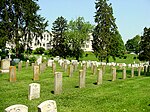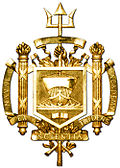United States Naval Academy Cemetery
| United States Naval Academy Cemetery | |
|---|---|
 Headstones at the USNA Cemetery | |
 | |
| Details | |
| Established | 1868 |
| Location | |
| Country | |
| Coordinates | 38°59′15″N 76°29′25″W / 38.98750°N 76.49028°W |
| Type | Veterans |
| Owned by | U.S. Department of the Navy |
| Size | 6.7 acres (2.7 ha)[1] |
| Website | United States Naval Academy Cemetery and Columbarium |
| Find a Grave | United States Naval Academy Cemetery |
The United States Naval Academy Cemetery and Columbarium is a cemetery at the United States Naval Academy in Annapolis, Maryland.
History

In 1868 the Naval Academy purchased a 67-acre piece of land called Strawberry Hill as part of their efforts to expand after the American Civil War.[2] Within a year of its acquisition part of the property became the cemetery. Since its beginning the cemetery has become the final resting place for Medal of Honor recipients, Superintendents of the Naval Academy, midshipmen, and former employees of the Academy and hundreds more of the nation's veterans.
The cemetery is also home to monuments that do not mark remains, but commemorate the heroism of individuals who gave their life in service to their country. The Jeannette Monument, erected in 1890, is the most notable such monument. It was built in memory of the men who lost their lives in the Jeannette Arctic Expedition.[3]
Columbarium
In 1987, the Naval Academy constructed a columbarium adjacent to the cemetery on College Creek. The columbarium was built by the Naval Academy Alumni Association with $500,000 in gifts from alumni and friends of the Academy. This included a major grant from the George and Carol Olmsted Foundation in memory of Jerauld L. Olmsted, Class of 1922. The columbarium offers resting places for those who wish to be inurned at the Naval Academy.
The columbarium is approximately 160 feet long and six feet high on a three-tiered pedestal. All exterior surfaces are white marble. Each niche front is removable by a special key. Niches are assigned in consecutive order and cannot be reserved in advance.
In front of the columbarium stands a memorial donated by the Class of 1937 in honor of the Academy graduates who died in the line of duty and whose bodies were never recovered.[1]
Notable burials




- Vice Admiral Bernard L. Austin (1902–1979)
- Captain Edward L. Beach, Jr. (1918–2002)
- Vice Admiral Donald B. Beary (1888–1966)
- Admiral Arleigh A. Burke (1901–1996)
- Lieutenant General Henry W. Buse Jr., USMC, (1912–1988)
- Lt. Cmdr. Wesley Brown (1927-2012)[4]
- William J. Crowe (1925–2007)
- Commander William B. Cushing (1842–1874)
- Lieutenant Commander George Washington DeLong (1844–1881)
- Theodore Gordon Ellyson (1885–1928)
- Ensign John R. Elliott (1977-2000)
- Rear Admiral Wilson F. Flagg (1938–2001)
- Ben Hebard Fuller (1870–1937)
- Rear Admiral Bancroft Gherardi (1832–1903)
- Lieutenant General George F. Good Jr., USMC, (1901–1991)
- Admiral James L. Holloway III (1922–2019)
- Rear Admiral Harold Hauser (1897–1981)
- Fleet Admiral Ernest J. King (1878–1956)
- Vice Admiral Herbert F. Leary (1885-1957)
- Vice Admiral Julien J. LeBourgeois (1923–2012)
- Captain Robert F. R. Lewis (1826–1881)
- Rear Admiral Charles Elliott Loughlin (1910–1989)
- Captain Bruce McCandless II (1937–2017)
- Senator John McCain (1936–2018)[5]
- Rear Admiral John Porter Merrell (1846–1916)
- Major General Charles D. Mize (1921-1998)
- Commodore James Philips Parker (1855–1942)
- Lieutenant Samuel W. Preston (1840–1865)
- Joseph M. Reeves (1872–1948)
- Rear Admiral Frederick Lois Riefkohl (1889–1969)
- Colonel John W. Ripley, USMC, (1939–2008)
- Clarence Wade McClusky (1902–1976)
- Vice Admiral Herbert D. Riley (1904–1973)
- Rear Admiral Thomas H. Robbins, Jr. (1900–1972)
- Rear Admiral Paul Wilhelm Steinhagen (1897–1968)
- Rear Admiral Charles J. Train (1845–1906)
- Stansfield Turner (1923–2018)
- Jesse Wallace (1899–1961)
- Lieutenant General Pedro Augusto del Valle, USMC, (1893–1978)
- Bandmaster Charles A. Zimmerman (1861–1916)
Medal of Honor recipients
- Thomas Calvin Cooney (1853–1907)
- Eugene B. Fluckey (1913–2007)
- Thomas Jones (1820–1892)
- Isaac Campbell Kidd (1884–1941)
- Bruce McCandless (1911–1968)
- Frederick Vallette McNair (1882–1962)
- Daniel Montague (1867–1912)
- Robert Sommers (1837–1919)
- James Bond Stockdale (1923–2005)
- William Peterkin Upshur, USMC, (1881–1943)
- Richard Wainwright, Jr. (1881–1944)
Superintendents of USNA
- James L. Holloway, Jr. (1898–1984)
- Charles Turner Joy (1895–1956)
- Draper Laurence Kauffman (1911–1979)
- Charles Cochran Kirkpatrick (1907–1988)
- Charles R. Larson (1936–2014)
- William P. Lawrence (1930–2005)
- William P. Mack (1915–2003)
- Ronald F. Marryott (1934–2005)
- Vice Admiral Charles L. Melson (1904–1981)
- Charles Stamps Minter (1915–2008)
- Louis M. Nulton (1869–1954)
Eligibility requirements
To be buried at the United States Naval Academy Cemetery is an honor; below are the eligibility requirements. Naval Academy graduates must attain a flag rank while on active duty in order to be eligible.[6]
1. Those eligible for burial in the Naval Academy Cemetery are:
- Officers, midshipmen, or enlisted persons of the Navy or Marine Corps on active duty at the Naval Academy, Naval Station, Annapolis, or the staff of the Naval Medical Clinic, Annapolis.
- Those Naval Academy graduates who have served on active duty with the rank of Rear Admiral or Brigadier General, or senior thereto, and such others as the Secretary of the Navy or the Superintendent may designate.
- Unremarried spouse of an officer or enlisted person of the Navy or Marine Corps who is buried or eligible to be buried in the Naval Academy Cemetery. In the event the spouse remarries, his or her eligibility is automatically terminated.
- Any officer, former officer, or enlisted person of the Navy or Marine Corps whose spouse is buried in the Naval Academy Cemetery.
- Stillborn and infant children of the officers or enlisted persons on active duty at the Naval Academy; Naval Station, Annapolis; or Naval Medical Clinic, Annapolis may be buried in a specific lot reserved for such cases. For purposes of this regulation, an infant is considered to be a child who has not reached 7 years of age.
- Graduates of the Air Force Academy or West Point who cross commissioned to the Navy or Marine Corps and completed 20 years of commissioned service with the rank of Rear Admiral or Brigadier General, or senior thereto.
- Distinguished Graduates of the Naval Academy.
2. Those eligible to make a reservation for future burial in section 17 of the Naval Academy Cemetery are Naval Academy graduates who have served on active duty with the rank of Rear Admiral or Brigadier General or senior thereto and such others as the Secretary of the Navy or Superintendent may designate. Individual lots in section 17 are not reserved in advance. They are assigned sequentially at the time of need.
3. Nothing in these regulations will change or alter cemetery reservations and commitments made under previous regulations.
References
- ^ "Frequently Asked Questions". US Naval Academy Cemetery and Columbarium. United States Navy. Retrieved 30 March 2020.
- ^ Benjamin, Park (1900). The United States Naval Academy. New York: G. P. Putnam's sons.
- ^ "The Jeannette Monument Unveiled". Daily Alta California. October 31, 1890. Retrieved December 7, 2019.
- ^ Witte, Brian (June 6, 2012). "Memorial Service for 1st Black Naval Academy Grad". NBC4 Washington. Retrieved 2019-12-07.
{{cite web}}: CS1 maint: url-status (link) - ^ Hayes, Christal (January 30, 2019). "In John McCain's final resting place, his legacy isn't politics but a life of service". USA TODAY. Retrieved 2019-12-07.
{{cite web}}: CS1 maint: url-status (link) - ^ "Cemetery and Columbarium Eligibility Requirements". www.usna.edu. Retrieved 2019-12-07.
{{cite web}}: CS1 maint: url-status (link)

